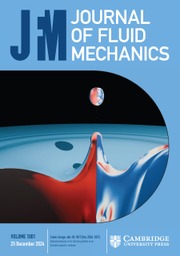Article contents
Proper orthogonal decomposition in Squire's coordinate system for dynamical models of channel turbulence
Published online by Cambridge University Press: 21 June 2005
Abstract
The convergence rate and the structures of the proper orthogonal decomposition (POD) reconstruction are re-examined. The relatively slow convergence rate of the wall-normal velocity and the over-prediction of the Reynolds shear stress from POD-based representations of near-wall turbulence suggest that coherent structures are too well correlated. This is a consequence of the directional preference of the eigenfunctions toward the most energetic data (the streamwise motion at $x^+_2 \,{=}\, 13$) which may be relaxed by extracting the POD eigenfunctions from the streak modes and the streamwise vortex modes separately. The rate of convergence and representation of structures may be improved by performing the POD in Squire's coordinate system (PODS). The statistical reconstruction of the localized ($x^+_2 \,{\leq}\, 84$) PODS eigen-functions from the large-eddy simulation (LES) database suggests that the convergence rate of component energy, Reynolds shear stress and the correlation coefficient of streamwise and wall-normal velocity improve significantly. The PODS eigenvalue spectra and the spatial structures of the eigenfunctions indicate the presence of observed streaks, streamwise vortices, and ejection/sweep events.
Dynamical models of the full channel turbulence are constructed by projecting the Navier–Stokes equations onto the PODS eigenfunctions. The unresolved modes are taken into account by closure models adapted from a constant eddy-viscosity model, dynamic Smagorinsky, and dynamic one-coefficient mixed subgrid-scale (SGS) model. Statistical moments obtained from PODS-based simulations are much more accurate than their counterparts from POD-based simulations. This is particularly true for the mean velocity, streamwise turbulent intensity, Reynolds shear stress and the correlation coefficient of streamwise and wall-normal velocity.
- Type
- Papers
- Information
- Copyright
- © 2005 Cambridge University Press
- 7
- Cited by


